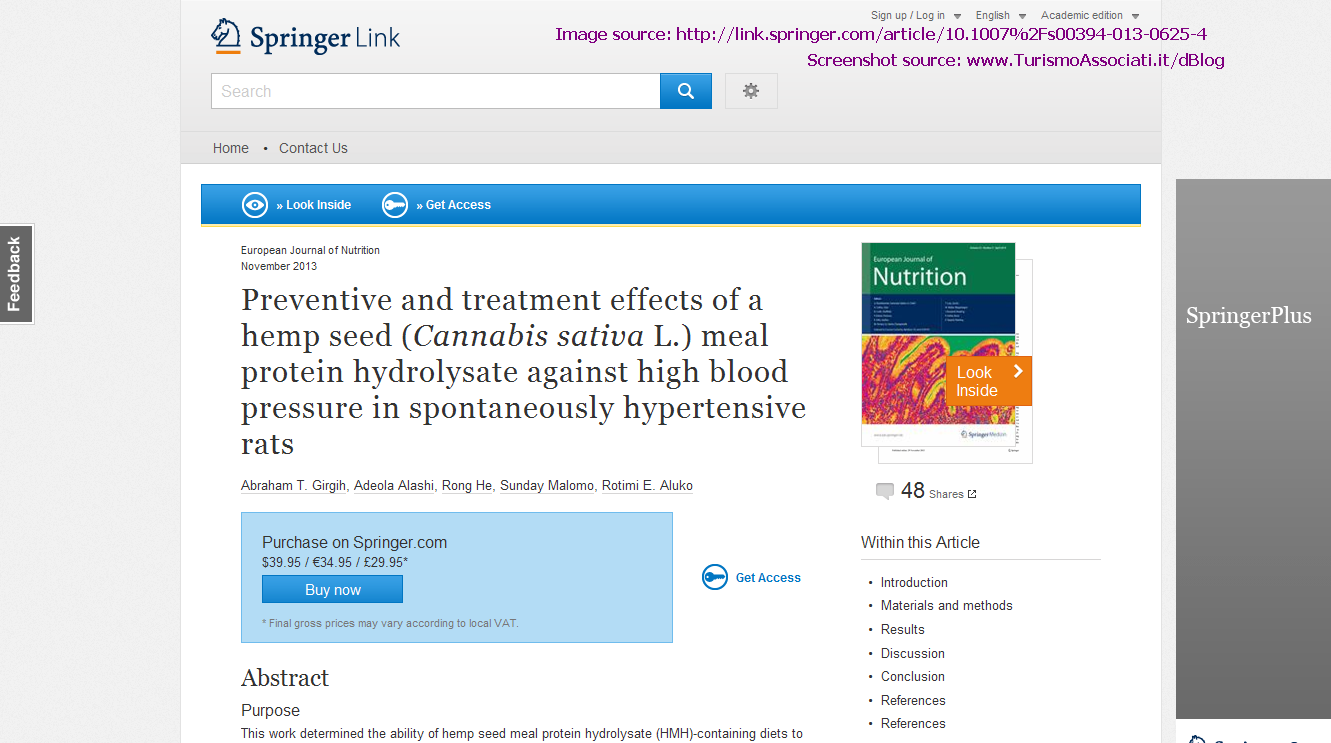|
Di seguito gli interventi pubblicati in questa sezione, in ordine cronologico.
Researchers at the University of Nottingham conducted a meta-analysis of previous studies, reports the Nottingham Post, concluding that cannabinoids could reduce the severity of stroke as well as improve neurological outcomes.

Lead author Dr. Tim England, honorary consultant stroke physician at the University of Nottingham and Royal Derby Hospital, presented the findings at this week's annual UK Stroke Forum conference.
Dr. England explained in an university release that while research thus far has been limited to animals, the latest findings provide support for human studies.

"This meta-analysis of pre-clinical stroke studies provides valuable information on the existing, and importantly, missing data on the use of cannabinoids as a potential treatment for stroke patients. The data are guiding the next steps in experimental stroke in order to be able to progress onto initial safety assessments in a clinical trial."
Dr. England and his team examined 94 past studies involving the effects of various cannabinoids on 1022 rats, mice or monkeys, reports The New Zealand Herald. The effects on stroke seemed to be consistent across all three types of cannabinoids: synthetic, marijuana-derived and those naturally produced by the body.
Dr. Dale Webb, director of research and information at the Stroke Association, also concluded that scientists should now aim to replicate the findings in humans.
"The findings have identified the potential for cannabinoids to reduce brain damage caused by stroke. Further research is needed to investigate whether cannabinoids have the same effects in humans: the effects of cannabis on the brain are highly complex and it remains a risky substance."
Following the presentation of the findings, Dr. Madina Kara, a neuroscientist at the Stroke Association, said that human trials are now "under discussion."
Source: NottinghamPost & NewZealandHerald via LeafScience
Researchers at Brigham and Women's Hospital and Harvard Medical School conducted a study comparing the psychoactive effects of Marinol (scientific name: dronabinol) – a THC pill used to treat nausea and weight loss in AIDS and cancer – with smoked marijuana.
Published in The Clinical Journal Of Pain, the team concluded that both forms of cannabis treatment have similar psychoactive effects.

"These findings imply that in our laboratory environment, dronabinol caused a 'high' similar to smoking marijuana when used for pain management."
Marinol was given to a group of 30 chronic pain patients who were also on opioid therapy. Their measurements were compared with 20 healthy subjects who received marijuana in joint form.
The study involved three separate laboratory visits, where participants were given the drugs and asked to complete a self-rated assessment commonly used to measure psychoactivity.
Although psychoactivity scores came back the same, the researchers did notice a difference in the time it took for effects to peak. The effects of marijuana peaked after 30 minutes, while Marinol's peak happened at around 2 hours.
The researchers suggest that a delayed peak may make Marinol less abuse-prone than smoked marijuana.
On the other hand, medical marijuana can be administered in edible form, which many say offers a similar delay. A recent study also suggests that patients who've tried different forms of marijuana prefer the whole plant over pharmaceutical preparations.
Nevertheless, the authors believe that increasing interest in cannabis-based medicine warrants further research on its abuse potential.
The study received funding from the National Institute on Drug Abuse (NIDA) and Solvay Pharmaceuticals, Inc.
Source: LeafScience
The work is being led by Dutch chemist and nanoparticle expert Willem Mulder, PhD, who has served as director of the Nanomedicine Laboratory at Mount Sinai since founding it in 2006.

Dr. Mulder and his team specialize in the use of nanoparticles in heart disease, and have recently taken an interest in the therapeutic potential of cannabinoids – a class of compounds found in marijuana.
Since 2005, pre-clinical evidence has shown that cannabinoids can slow the progression of atherosclerosis – a disease of the arteries that underlies various heart conditions – in mice.

Cannabinoids appear to be a promising treatment because of their anti-inflammatory properties. However, research in humans faces a number of barriers.
Dr. Mulder and his team believe that creating nano-drugs from cannabinoids may help to overcome one of the largest of these barriers: the 'high.'
Dr. Mulder has previously shown that nanoparticles, which are composed of an outer layer of fatty molecules, possess a natural attraction to the atherosclerotic plaque that accumulates on the inner walls of blood vessels.
By delivering cannabinoids via nanoparticles, Dr. Mulder says the drugs will never have to reach the brain, thereby avoiding any psychoactive effects.
Dr. Mulder told AD.nl in a recent interview that he hopes to start the first human trials sometime in the next 5 years. But in total, he says it could take 15 years for the therapy to reach the clinic.
Funding is another major obstacle of his research. In order to raise support for his work, Dr. Mulder has partnered with a team of Dutch filmmakers that are documenting his progress.
Led by Gert van Kempen, the High On Nano project will release a series of short films that will help bring the research to the public eye. They plan to raise €30,000 in order to begin production of the first episode by Spring 2014.
Source: AD.nl via LeafScience
GW Pharmaceuticals announced that it has been issued a Notice of Allowance from the U.S. Patent Office for a patent application involving the use of THC and CBD, the two main chemicals in marijuana, for treating gliomas.
Once a patent application is deemed a genuine invention, the Patent Office sends a Notice of Allowance that outlines the fees involved with final approval.

Specifically, the company provides this description of the patent:
"The subject patent specifically covers a method for treating glioma in a human using a combination of cannabidiol (CBD) and tetrahydrocannabinol (THC) wherein the cannabinoids are in a ratio of from 1:1 to 1:20 (THC:CBD) with the intent to reduce cell viability, inhibit cell growth or reduce tumor volume."
Filed in 2009, GW's patent application lists Otsuka Pharmaceutical as a collaborator and initially claimed the invention of the "use of a combination of cannabinoids in the manufacture of a medicament for use in the treatment of cancer."
However, it's likely that the application was revised since then to be more specific in its claims, including the ratio of THC to CBD used and the type of cancer treated.
Indeed, the use of cannabis and cannabis-derived chemicals to fight a wide range of cancers has long been suggested by pre-clinical research as well as anecdotal reports.
On the other hand, the first clinical trial to investigate these cancer treatments only began in november 2013, launched by GW Pharmaceuticals for their cannabis drug Sativex.
The trial investigates Sativex in combination with the standard chemotherapy drug temozolomide, and involves 20 patients with recurrent glioblastoma multiforme (GBM), an aggressive and rare form of brain cancer.
GW Pharmaceuticals also announced in November 2013 that it had begun human trials of a CBD-rich cannabis drug for the treatment of pediatric epilepsy.
Source: LeafScience
Published in the December 2013 issue of Epilepsy & Behavior, the survey compiled responses from 18 parents who had turned to CBD (cannabidiol)-rich cannabis extract to treat their child's severe epilepsy.
Of those surveyed, 83% indicated a reduction in their child's seizure frequency. Parents reported little to no side-effects of cannabis treatment, and, in some cases, a reduction in seizure frequency of up to 80%.

Thirteen of the children suffered from Dravet syndrome, four had Doose syndrome, one had Lennox-Gastaut syndrome and one had idiopathic epilepsy.
The study was led by postdoctoral fellow Catherine Jacobson, PhD, who believes in spite of the study's obvious weaknesses, that the results still support CBD-rich cannabis as an effective epilepsy medicine.
"Even given the caveats of the study, which are big, I believe that CBD will work for some children that are currently still seizing despite their trials of available anti-seizure drugs."
Dr. Jacobson says she was inspired to conduct the study by her own search for a treatment that could help her epileptic son. After hearing that some parents were having success using CBD-rich cannabis, she reviewed the literature and found research dating back to the 1970s that supported the anecdotes.
And while medical marijuana is legal in her home state of California, Dr. Jacobson believes that more research needs to be done in order for CBD to be widely accepted and available.
"Now the work begins, though, to find out which types of epilepsy it's going to help, how CBD interacts with other anti-seizure drugs, and what really are the side-effects?"
CBD remains strictly prohibited as a Schedule I drug, making it difficult for parents in many states to access the treatment. However, significant progress has been made in the past year towards achieving federal recognition of CBD as a medicine.
In fact, Dr. Jacobson is now part of a team at University of California, San Francisco (UCSF) that is leading clinical investigations on a high-grade CBD extract developed by GW Pharmaceuticals.
Just last month, the company announced that it had received FDA approval to begin experimental treatments with the new drug, Epidiolex, in epileptic children.
Research is being led by Roberta Cilio, MD, PhD at UCSF and Orrin Devinsky, MD at the NYU School of Medicine, and initial results are expected.
Source: LeafScience
Here we count down, in no particular order, a few (of the many) reasons why this year was memorable for cannabis research.

1. FDA approves first clinical trials of marijuana for paediatric epilepsy
Evidence that marijuana can help in a wide range of epileptic conditions dates back to the 70s. But it wasn’t till this year that research progressed to the stage of FDA-approved clinical trials.
Likely due, at least in part, to growing interest from the media and awareness among parents with epileptic children, a company called GW Pharmaceuticals this year became the first ever to initiate clinical trials of a cannabis-based epilepsy treatment. The drug is called Epidiolex and is a liquid extract high in the non-psychoactive marijuana chemical called cannabidiol (CBD).
Initial results are expected early 2014 and, if successful, may not just bring relief to thousands of children across the U.S for whom traditional medicines don’t work. In fact, clinical evidence that cannabis extract helps in paedetric epilepsy could very well lead to the rescheduling of cannabis under U.S. federal law.
Read more: New Cannabis Drug Approved For Trials In Children With Epilepsy
2. Scientists show that various chemicals in marijuana can kill leukemia cells
Evidence that marijuana can kill cancer cells has also existed for decades. But this year, research from the University of London revealed something very interesting.
Using leukemia cell lines, the study identified the cancer-fighting potential of a number of lesser known, non-psychoactive chemicals in marijuana.
Unlike THC, the compounds that were used in the study – cannabidiol (CBD), cannabigerol (CBG) and cannabigevarin (CBGV) – can’t get patients high. Significant media attention was paid to this point. On the other hand, it’s doubtful that getting high is a major concern of anyone battling cancer.
Read more: Cannabinoids Destroy Leukemia Cells, New Study Finds

3. First clinical trials of marijuana for brain cancer begin in the UK
On top of breakthroughs in non-psychoactive cannabis treatments, 2013 also marked the launch of the first ever human trials of cannabis-based cancer medicine.
In November, GW Pharmaceuticals announced the start of Phase 1b/2a clinical trials of their pharmaceutical cannabis spray, Sativex, as an add-on treatment for aggressive brain cancer. The two-part trial involves giving Sativex to 20 patients with recurrent gliobastoma multiforme, in addition to the standard chemotherapy drug temozolomide.
While THC and CBD have both been shown to kill cancer cells on their own, some research suggests that combining marijuana compounds with traditional chemotherapy drugs can have even greater anti-cancer effects.
Read more: Cannabis Treatment For Brain Cancer Begins First Human Trials
4. Researchers show that marijuana can help cigarette smokers quit
Marijuana may not just be a safer recreational drug than cigarettes, but apparently it can also help cigarette smokers quit. The first human study to investigate this was conducted at the University College London, with the results published September this year.
The small, placebo-controlled trial involved the non-psychoactive marijuana compound CBD administered via vaporizer, which subjects were instructed to use whenever they felt the urge to smoke.
After one week of treatment, those who received actual CBD showed a 40% reduction in the number of cigarettes smoked, compared to the placebo group. The researchers concluded that the results were promising, but since the study only involved 24 subjects, larger studies are still needed.
Read more: Can Marijuana Help You Quit Cigarettes? Study Says Yes
5. Scientists provide first clinical evidence that marijuana helps in Crohn’s disease
In May, researchers out of Israel published results from the first human study investigating smoked medical marijuana as a treatment for Crohn’s disease. While the study was rather small, only 11 patients were involved, daily doses of medical marijuana led to complete remission in 5 of the patients.
Medical marijuana also helped patients wean themselves from dependency on steroid-based medications and improved their appetite and sleep, with “no significant side effects.”
While the study focused mostly on symptom measurements, the results may also support earlier findings from animal studies showing that compounds in marijuana can actually treat the underlying cause of Crohn’s and other inflammatory bowel diseases.
Read more: Cannabis induces a clinical response in patients with Crohn’s disease: a prospective placebo-controlled study.
6. Scientists provide first clinical evidence that marijuana helps in Parkinson’s disease
With animal and cell culture studies suggesting that marijuana may slow the progression of Parkinson’s, it was only a matter of time until human research was conducted.
Thankfully, Israeli researchers also published the first ever human study of medical marijuana for Parkinson’s this year. Although only 20 patients were involved, the results showed clear improvements in symptoms of tremor, rigidity and bradykinesia.
Patients also reported a dramatic reduction in pain associated with their disease, which led to improvements in sleep. Overall, measurements of disease severity taken after patients smoked medical marijuana showed a significant decline that lasted for around 2 to 3 hours.
Read more: Smoking Pot Eases Tremors in Parkinson’s
7. Harvard study shows smoking marijuana may make you skinnier and reduce the risk of diabetes
This year, an observational study involving over 4,600 adults, conducted at Harvard University, revealed a rather surprising link between marijuana use and slimmer waist lines.
Although suggested before, the link still seems counter-intuitive, since marijuana isn’t known for reducing food intake, but rather the opposite. Indeed, other studies suggest that marijuana users have a significantly higher calorie intake than non-users.
However, the Harvard study also found lower levels of insulin blood levels and insulin resistance among marijuana users, as well as higher levels of the ‘good’ type of cholesterol (HDL), all of which are believed to lower the risk of diabetes.
Considering the newest data, the researchers concluded that while marijuana is well known for stimulating a desire for unhealthy foods, it may have some less obvious metabolic effects that could be healthy in the long run.
Read more: Marijuana: The Next Diabetes Drug?
Source: LeafScience
Researchers at the University of Manitoba believe hemp seeds could offer a safer alternative to drugs traditionally prescribed for hypertension. Previous studies, they note, suggest that proteins found in hemp seed possess a variety of cardiovascular benefits.
"Preliminary in vitro studies have shown that industrial hemp seed peptides possess both antioxidant and antihypertensive properties."
In a new study, published in the European Journal of Nutrition, the team found that an 8-week diet of hydrolyzed hemp protein could slow the development of hypertension in genetically-prone rats.

What's more, the diet was also effective at reducing signs of hypertension – plasma ACE and renin levels – in rats with already established conditions.
"The results confirm the potential of HMH (hemp seed meal hydrolysate) as a useful ingredient that can be used to formulate functional foods and nutraceuticals for the prevention and treatment of hypertension."
While a number of foods have been found to help control blood pressure, the researchers suggest that the protein content of hemp seeds, as well as being easy to digest, make it an ideal choice.
"The presence of superior amino acid profile in hemp seed proteins (principally identified as edestin and albumin) and high digestibility promotes their efficacy as a source of health-enhancing bioactive peptides."
Despite the positive results, more work still needs to be done. The team says the next step is to identify and purify the protein sequences responsible for its antihypertensive effects.
The study received funding from the Manitoba Agri-Food Research and Development Initiative (ARDI) and the Natural Sciences and Engineering Research Council of Canada (NSERC)
Source: LeafScience
In a recent ‘Ask The Doctor’ column, Dr. Heather Auld, Fellow at the University of Arizona Department of Integrative Medicine and a practising obstetrician/gynecologist, explained why the time has come for marijuana to be placed back into the U.S. pharmacopeia.
1. Marijuana has been used as medicine for more than 3,000 years
The use of medical marijuana has been traced to ancient civilizations in China, India, and Egypt. One of the earliest pieces of evidence is a book written by Chinese Emperor Shen-Nung in 2737 BCE, which described the benefits of cannabis in treating constipation, gout, rheumatism and absent-mindedness.
Dr. Auld writes that “only in recent decades has it been removed from our pharmacies.”
2. The American Medical Association supports medical marijuana and its use in research
When marijuana prohibition was passed in 1937, the American Medical Association (AMA) was one of the only voices of opposition. Indeed, the AMA was well aware that marijuana, since entering Western medicine in the mid-1800s, was commonly prescribed for a wide range of conditions.
Though synthetic drugs grew popular during the 20th century, the AMA has continued to support research on marijuana’s medical potential, a position they maintain to this day.

3. The ‘high’ is only from one component
Cannabis contains more than 400 chemical compounds, of which more than 60 have been identified as cannabinoids. Cannabinoids are the medically active ingredients in cannabis, including the one that gets you high, tetrahydrocannabinol (THC).
But other cannabinoids are known to offer similar medical benefits, without the high. Cannabinoids like cannabidiol (CBD), cannabigerol (CBG), and tetrahydrocannabinolic acid (THC-A) have been extracted from cannabis to produce non-psychoactive forms of medical marijuana. These are especially popular for paediatric patients.
4. Our body contains a natural cannabinoid system that regulates health and illness
It wasn’t until the mid-1990s that scientists discovered why marijuana works so well, and for so many different illnesses. The discovery was a natural system in the human body called the endocannabinoid system, which includes chemicals that mimic the activity of cannabis, called endocannabinoids.
Much like cannabis, Dr. Auld notes that endocannabinoids act to “decrease inflammation, increase immunity, decrease pain, and increase appetite.”
5. Smoking or vaporizing marijuana is better for pain relief
Although some believe there are better methods than smoking or vaporizing, Dr. Auld argues that it could be ideal for those in pain. Oral ingestion of cannabis provides longer-lasting relief, but also takes about an hour to achieve effect. Patients in pain usually require more immediate action, which smoked or vaporized marijuana provides.
6. Marijuana may be superior to narcotic painkillers for neuropathy or nerve pain
While opioid painkillers are incredibly potent and can work wonders for certain types of pain, they are much less effective in cases of nerve pain. In studies, marijuana performs just as well as gabapentin, a leading pharmaceutical used to treat neuropathy.
Also, Dr. Auld notes that “whereas narcotics commonly increase nausea and vomiting, marijuana relieves those symptoms.”
7. When combined, marijuana can decrease the amount of narcotics needed for pain relief
Studies suggest that marijuana can reduce the need for prescription painkillers when given together. The popularity of painkillers has led to a rise in accidental overdoses in the U.S., with opioids claiming over 16,000 lives in 2010. By reducing the need for high doses, medical marijuana offers a promising solution for doctors and patients.
8. The main side effect of marijuana is euphoria or extreme feelings of well-being
One of the most common reasons for doctors to dismiss medical marijuana is the unwanted side effect of getting high. Yet those who have never experienced a marijuana high can easily forget what the high actually does. Feelings of euphoria, while unwanted for some, can provide comfort for patients with debilitating or chronic illnesses.
9. Unlike highly addictive narcotic painkillers, marijuana has the same addictive potential as caffeine
Even when compared to common recreational drugs, studies have ranked marijuana among the least addictive.
A study conducted by NIDA researchers concluded that 9% of people who ever try marijuana will become addicted to it at some point, which is similar to caffeine. On the other hand, the same study found an addictive potential of 15% for alcohol and 32% for tobacco.
10. Marijuana is being studied as a treatment for tumors and various forms of cancer
For cancer patients, relief of nausea and pain are not the only potential benefits of marijuana.
In fact, compounds in marijuana have shown anti-tumor and anti-cancer effects in numerous animal models, “particularly in brain and skin tumors,” Dr. Auld writes, “but also in lung cancer, lymphoma and colon cancer.”
Last November 2013, a drug company called GW Pharmaceuticals began the first clinical trials of a marijuana-based treatment for battling cancer.
Source: LeafScience with LINKS for each point!
There is a Facebook group called The Exposing The Truth Group (link here) that has a very fascist way of banning members who try to tell any truth. We will only post the two comments we made on the group and let you, the reader, "judge" the situation...
"I do not agree with what you have to say, but I'll defend to the death your right to say it." - Voltaire
Somebody in that group posted the image bellow with this text: "Imagine what our country would be like if we legalized explosives. Can you imagine a world where that wouldn't be a safety hazard? Then share this to stand up for sensible gun control!". So we, from TurismoAssociati.it made this comment: "Let me tell you this: I lived in a society where guns were illegal to possess and I never had a gun pointed in my face. Time passes and the same country made legal guns with rubber bullets: heard of many cases where people lost an eye from people shooting at strangers casually when angry... My opinion: nobody should have guns, not the police pigs or the damn military!" What happened? Some paranoid Admin, called Cairenn Day (link here) answered: "Bye F T (Ford Turani - TA note), I warned folks about the nasty names for police" and quickly banned us from the group!

The thing is many members of that group have doubts of the True intentions of the administrators... Michael A. Pizza: "I thought this sight is all about Exposing the Truth? What you showed us all has nothing to do about any truth. It just your arrogance that your Exposing. Enough said time to move on and close this account , you cannot explain things to people that don't have any common sense!" or Ayeisha Quinones: "... the truth evades you and everyone else with your mindset. It is what it is. ... the people who keep denying the negative impact of widespread guns in society are deniers."
But here you have one of the admins, Cairenn Day that infiltrated the group just to hide and censure any position of truth: "M A P, we are doing our best to get folks to stop believing every piece of nonsense on the web".
That group is full of brainwashed individuals: Janice Gordon: "Besides which, openly flaunting such weapons only serves to make you the first target a criminal is likely to go after. Much better to carry concealed, like I do."
Who are we, to explain to the americans that, in the United Kingdom for example, the police DO NOT carry a gun! They are not allowed. So, in this way are avoided the situations where some rookie or racist cop shoots by mistake any bystander...
Some other user posted this message on the group: Colleen Vanskiver: "/ExposingTheTruthGroup/ What a joke this group is" and a genius asked: Andrew Hudak: "Why would you join a group that you do not like?" But here comes the admin: Cairenn Day: "What is your objection here, please?", but you must read this:
Mario E Gilberto: "There are plenty of facts. I can, for example, show you 2000+ peer-reviewed studies which show that GMOs are safe. Many of them come from independent outlets. Isn't that creditable?" Cairenn Day: "I can show you how contrails form and that chemtrails are a hoax" Dee Junior: "Gmo's are probably safe it's the government control of their producers that concerns me!" Cairenn Day: "The government doesn't control farmers or companies."
We asked Aaron Jackson (link here), the main Admin of the group to insert us again and we posted: "With fascist admins like Cairenn Day, that ban members for stating "police pigs should not have guns".., this should be called the Hiding The Fascist Joke Group!" and Cairenn answered: "F T has been sent to the woodshed again". Four likes for her/his statement!

Need any other proof that this group has nothing to do with the truth and the freedom of expression? Our advice: be very careful with the FascistBook groups, because any group can become administrated by false "truthers" who infiltrate to divide and destroy... "None are more hopelessly enslaved than those who falsely believe they are free." - Johann Wolfgang von Goethe
This article is dedicated to Richard Clarke, a truth researcher who posted his findings and observations on FaceBook, until his account got reported or/and cancelled and there was no trace of him on the "CIA social network"...
Doru Trifan for www.TurismoAssociati.it
Di Salvatore Santoru
Recentemente Wikileaks ha pubblicato una bozza del trattato " TISA " (Trade in Services Agreement) , un'accordo riservato tra 50 paesi, il cui scopo sarebbe quello di cancellare il potere d'intervento dei governi e lasciare mano libera alle banche e alle multinazionali .
Come scritto da Marco Schiaffino sul Fatto Quotidiano, l'obiettivo dell'accordo è quello di " eliminare tutte le leggi nazionali che sono considerate come “ostacoli” al commercio dei servizi in ambito finanziario ", ovvero "un copione che ricalca i trattati approvati nel 2000 e che, secondo molti economisti e governi, hanno rappresentato la causa principale della recente crisi finanziaria globale ".

Tra le norme da eliminare, spiccano quelle relative ai limiti alle dimensioni degli istituti finanziari, imposti in alcuni paesi per evitare quelle operazioni di salvataggio obbligate nei confronti di quegli istituti ( principalmente banche ) considerati " troppo grandi per fallire ".
Nelle proposte del trattato inoltre si sollecita la privatizzazione della previdenza e delle assicurazioni e l'eliminazione degli obblighi di divulgazione di operazioni offshore nei paradisi fiscali.
Il trattato rappresenta una vera e propria proposta di deregulation totale per le banche e i grandi istituti finanziari, una sorta di manifesto per una prossima " dittatura finanziaria " di cui a beneficiarne saranno i pochi " signori del denaro " a scapito dei cittadini sempre più schiacciati da tasse e i cui soldi spesso sono usati proprio per salvare quegli istituti finanziari ( come nel caso delle vicende delle banche " too big too fail " ) in gran parte responsabili della crisi attuale .
Come avevo scritto in un recente articolo, il sogno dei gruppi di potere finanziario è : " un mondo completamente schiavo del denaro ( anche elettronico ) e totalmente mercificato , dove ogni individuo terrestre sia essenzialmente dipendente del sistema finanziario e privato di ogni radice . Un mondo totalitario unito dalla fede nel Dio Denaro e nei suoi creatori " .
Insomma,il cosiddetto " Nuovo Ordine Mondiale " .
Fonte: informazioneconsapevole.blogspot.it
|